Engaging children in reading and language development is a multi-dimensional process that benefits greatly from interactive and practical learning activities. The Ladybird Key Words form presents a structured method that enriches this learning experience through a series of books and extension activities. With titles like "Play with us," "Look at this," and "Read and write," this approach fosters a fun and immersive environment where children not only learn to read but also to express themselves, work in pairs, and participate in group discussions. From miming games that enhance vocabulary understanding to writing and acting exercises that boost confidence in verbal expression, every activity is designed to make the learning process engaging and comprehensive. The form emphasizes the importance of personal interaction, creativity, and the use of imagination, inviting children to explore different scenarios, from shopping and helping at home to adventures with pets and excursions to the farm. Teachers are guided to facilitate these activities, encouraging students to recall details, articulate preferences, and interact with their peers in meaningful ways, thus building a solid foundation for early literacy and social skills.
| Question | Answer |
|---|---|
| Form Name | Ladybird Key Words Form |
| Form Length | 19 pages |
| Fillable? | No |
| Fillable fields | 0 |
| Avg. time to fill out | 4 min 45 sec |
| Other names | peter and jane pdf, peter and jane 3a pdf, peter and jane 1a pdf download, peter and jane 1c pdf download |
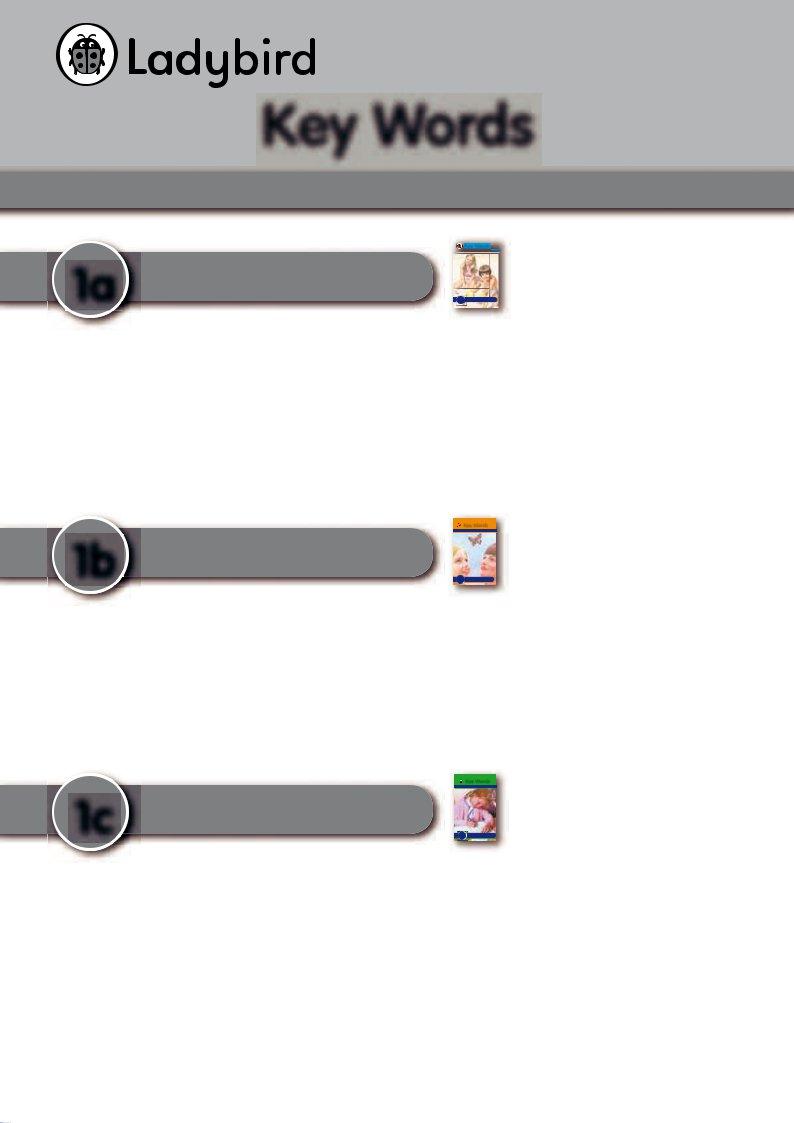
Key Words
Key Words Reading Scheme – extension activities
|
|
Key Words |
||
|
|
WITH PETER AND JANE |
||
1a |
Play with us |
|
|
|
|
1a Play with us |
|||
|
|
|
|
|
Ask your class to get into pairs. Taking turns, the members of each pair say I am here and here is ….. and introduce their partner.
This book is an ideal basis for a miming game Things we like.
Ask your class to tell you the things they like, give them words they do not know, and write all these things on the blackboard. Then ask individuals to say I like… and mime what it is they like.
Other members of the class will guess what this is, saying You like… and the child miming will answer, Yes, you are right, I like… Or No, you are not right.
Key Words
WITH PETER AND JANE
1b |
Look at this |
|
1b |
Look at this |
This book will help your class to enjoy a simple focus on shops and shopping.
Look at the things in Jane’s shop (pages 26 – 34). Can they remember what they have seen? Write a list on the board.
Ask your class, who is in Jane’s shop? and see if they can remember. What kinds of shops do they know? Write a list of shops on the board. Where do they like to shop? Individuals can answer I like to shop in a…
Key Words
WITH PETER AND JANE
1c |
Read and write |
|
1c Read and write
It’s important that all members of your class have the opportunity to read aloud from their own writing.
What do your class like to write? Teach the word about and ask your class to write and complete their own sentence: I like to write about … (Jane, the dog, the tree, the toy, the shop etc).
Ask each member to read his or her sentence aloud.
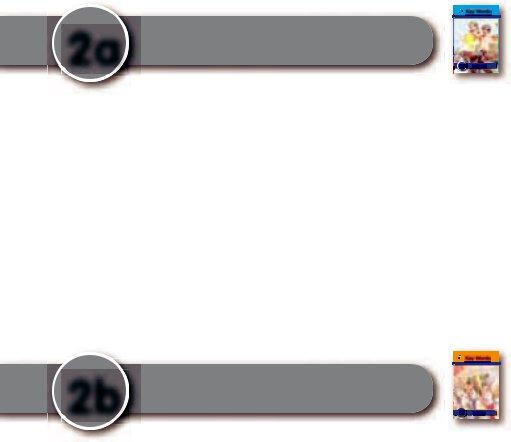
Look at me… is another useful miming game based on the books in this level.
Each child takes it in turn to say, Look at me, I like… And then mimes what it is they like – either from the books or from the work on things they like in books 1a.
The class guess what it is the child miming likes, and the child miming replies either,
Yes, you are right, I like… or No, you are not right.
2a |
We have fun |
|
Key Words
WITH PETER AND JANE
2a We have fun
This book is a great basis for language and reading development through acting.
Plan a class focus In the water.
Individuals can act Peter and Jane, and Pat the dog.
As you
Choose a short episode to act. Make sure that the actors know what they will be saying – and that the child playing Pat the dog understands what he has to do!
Enjoy talking about the seaside and write new words on the blackboard. Your class could plan a seaside poster and label what they draw.
Teach your class how postcards are sent from the seaside. Cut white card for them and ask them to make postcards of the seaside. Display all of these.
Key Words
WITH PETER AND JANE
2b |
Have a go |
|
2b |
Have a go |
This book provides an excellent starting point for a class focus on fun.
Write We want some fun on your blackboard and ask the class to use the words in the book and other words they know or would like to use to tell you what fun they like.
You could start them off:
I want to have some fun in the tree
And elicit answers such as:
I want to have some fun in the shop I want to have some fun with the dog want to have some fun with sweets
Help with constructions they do not know.
The fairground episode in Have a go is an exciting basis for reading and language development.
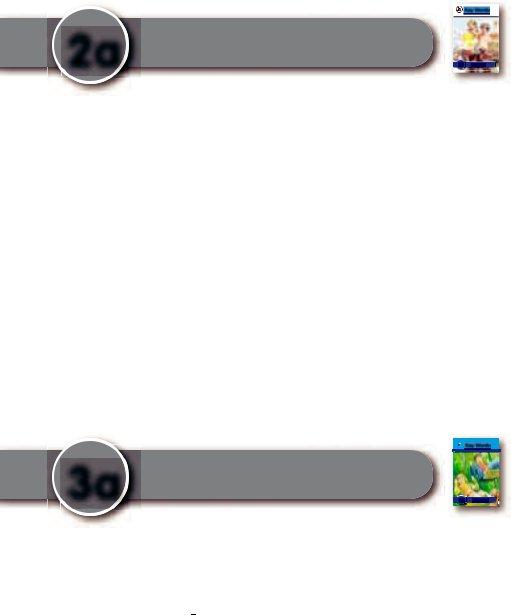
Look at the details on pages 44 – 51 and talk about fairgrounds, giving your class words such as helter- skelter, coconut shy, and big wheel.
Help the children to make up a fairground play and take it in turns to act this.
Several children will say, Can I have a go? and the child in charge of the ride or stall will reply
Yes, you can have a go.
Another child can say I want some ice cream. Can I have some? And the child in charge of the ice cream will reply, Yes you can have some ice cream. Here it is.
Yet another child will play the part of mother or father and tell the children
Come on Peter, come on Jane. I want to go home.
|
|
Key Words |
|
|
WITH PETER AND JANE |
2a |
I like to write |
|
|
2a We have fun |
Peter and Jane’s toyshop will encourage your class to make their own class toyshop and to label it. Give them any new words they do not know. There are more toys to look at on pages 33, 37,
39.When they have done this, choose a ‘shopkeeper’ and each member of the class can take a turn to use the shop saying the words they have read and completed on pages 10, 11. Change the names as appropriate.
Using the words they have read and written (and any new words they request), suggest each member of your class writes a short note (see page 13). Can they write about what they want to do?
If necessary, give an example:
I want to go to the shop.
I want to write.
I want to go to the water.
Have a class
Key Words
WITH PETER AND JANE
3a |
Things we like |
|
3a Things we like
The events in this story focus on boats, buses, cars and trains.
Ask your class what other vehicles they can think of and write the words they need on the blackboard.
Teach the word best and ask your class to tell you which vehicle they like best.
I like the car best
I like the boat best …

Use the dialogue on page 14 to plan a class discussion of picnics. What can they see in the picture? What would they like to bring to a picnic? Where would they like to go for their picnic?
Make sure your class know which parts of the text on page 14 are dialogue and which are not. Then ask the class to read the dialogue and you read says Peter, he says, says Jane.
Talk about pets. What animals would they like as a pet? Make and label a class picture of pets. Try a pet miming game. Each child takes a turn to mime a pet, and looking after the pet. The others guess what the pet is. Are you a…?
The child miming replies: yes, that is right, I am a
Or no, that is not right, I am not a…
Key Words
WITH PETER AND JANE
3b |
Boys and girls |
|
3b Boys and girls
Can your class remember how Peter and Jane help at home. How do your class help at home?
Ask your class to tell you how they help, and write on the blackboard words they do not know. Follow this with a miming game. Each child takes it in turns to say Yes, I help at home, and I …..
and to mime how they help . The others guess what it is they do.
Ask your class to answer your questions about Peter and Jane at the station and encourage them to answer as fully as possible:
How did Peter and Jane get to the station?
What colour was the bus?
Does Jane like to go on trains?
Does Peter like to go on trains?
Did you see Pat the dog at the station?
Enjoy a colour quiz. What red things can they see in the story?
Encourage them to reply:
I can see a red ball.
I can see red apples.
I can see a red bus.
I can see red lowers.
I can see a red boat.
Give them the words of any other red things in the story.
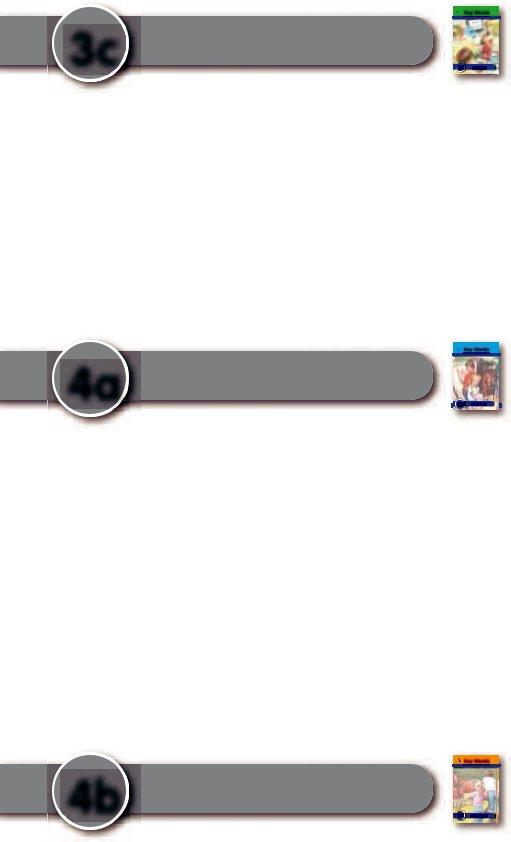
Key Words
WITH PETER AND JANE
3c |
Let me write |
|
3c |
Let me write |
Use page 24 as the basis of a discussion of the police and other people who help us.
Ask your class to help you to make a list of these people on the board. Then ask the children to copy these words and learn them. Ask them to write these words in sentences such as
The iremen help you.
The doctor helps you.
When they have written these sentences, ask each member of the class to read aloud what they have written.
Look at Jane’s teashop. Help your class to set up a pretend teashop and take it in turns to be customers, asking for tea and cakes. Help your class to write a simple menu and price list.
Key Words
WITH PETER AND JANE
4a |
Things we do |
|
4a Things we do
Enjoy a question and answer session based on this book:
Ask your class What can you make? And individuals will answer:
I can make a car, I can make cakes …
Ask your class What can you draw? And individuals will answer:
I can draw a red car, I can draw a house in a tree …
When you
The episode in which the cat climbs the tree (page 48) is ideal as a basis for acting.
Draw the attention of your class to the speech punctuation “” and make sure they understand which words are spoken and which are not.
Key Words
WITH PETER AND JANE
4b |
Fun at the farm |
|
4b Fun at the farm
This book offers an exciting focus connected with farm life.
When they have read the story, ask your class how many animals they can remember on the farm. Write the animals on the board, then read the story again to make sure you have found them all.
Talk about farming in your own country and give your class the words they do not know.
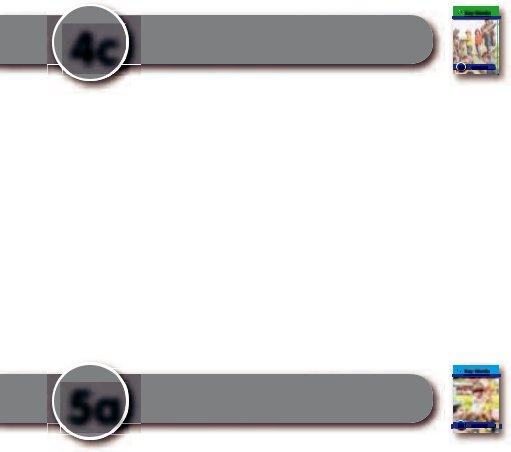
Ask your class to use the words they have read and any new words to write their own short sentences about Life on a farm.
You could give one of these as an example:
I go on a big horse. I play with the farm cat. I see some cows.
Ask individuals to read what they have written. Alternatively, ask individuals to make up sentences without writing them, and say them aloud to you.
Help your class to make and label a poster Life on the farm or stick labelled pictures in an album.
Key Words
WITH PETER AND JANE
4c |
Say the sound |
|
4c Say the sound
Use the pictures on pages 17 and 19 to make and label a class alphabet letters and sounds album. Label each object with the complete word.
Enjoy a how many words…Quiz.
Choose a letter from the letter/sounds they are learning and ask them to tell you as many words as they can which begin with that letter sound.
Read the book again and see if they can ind any more.
Use magnetic letters or make sets of letters on cards.
Show the children how to build up words with these and see how many words they can make on their own.
The big ire at the farm (pages 44 – 48) is ideal for acting, or
Key Words
WITH PETER AND JANE
5a |
Where we go |
|
5a Where we go
Bring maps to show your class and talk about the way maps are used.
Talk about the family journey to the hill. Can the class remember what Peter and Jane and their parents saw and did on the way to the hill?
Ask each member of the class to draw and label a simple map of the way to the hill and to include the bus stop, the river, the bridge, lots of trees and the farm. Remind them that the family could see the sea, and it would be good to put this on their maps, too.
The episode of Pat and the rabbits (pages 22 – 25) is an exciting base for a short class play. Make sure the class understands which words are spoken and draw their attention to the use of speech punctuation - “”.
The family go home on a train, and then a bus. Do your class remember what happened and what they saw?
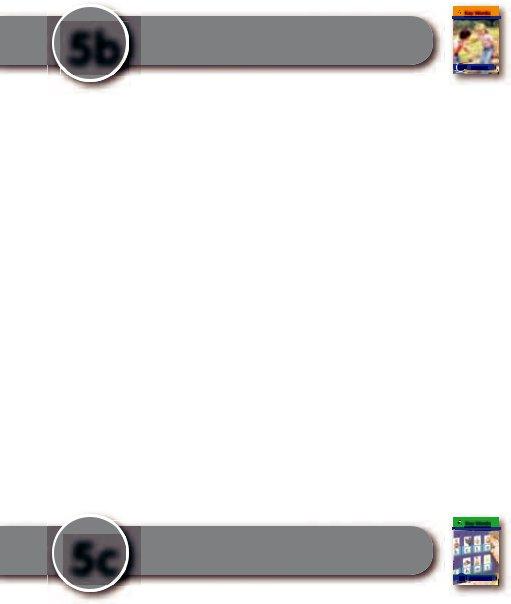
Key Words
WITH PETER AND JANE
5b |
Out in the sun |
|
5b Out in the sun
This book is an ideal basis for a discussion on family life.
Talk about families.
What family words do they already know? What new words do they need?
Who is in their family and what are their names? Explain simple family trees and help them to draw their own.
Talk about times of day. Write the words morning, afternoon, evening and night and ask your class what happens during these times. Give them all the words they do not know and list as many activities as you can.
Enjoy a quiz –
Who can remember what Peter and Jane saw in the town?
Who can remember what Peter and Jane saw as they went up the hill? Who can remember what Peter and Jane saw on the farm?
Who can remember what the girls did in the afternoon? Who can remember what the boys did in the afternoon?
Use pages 38/39 to encourage your class to discuss the kind of work they would like to do when they grow up. Give them any English words they do not know.
Key Words
WITH PETER AND JANE
5c |
More sounds to say |
|
5c More sounds to say
Look at the pictures on page 4.
Ask individuals to say the sound and then to say what the picture is.
Ask them to do it like this:
The sound is b and in the book I can see a picture of a boy.
Do the same with page 7.
When your class has read pages 8 – 15 several times, cover up the text and ask them to look at the pictures and to tell you the sounds and the words. Do the same with pages 18 – 27.
The story, beginning on page 28, will help you to discuss journeys.
What journeys have the children in your class had? What can they remember? How did they travel? Who were they with? What happened and what did they see?
Talk about Jane and Peter’s afternoon on the boat. What did the boys do? What did the girls
do? What did the children see in the shop?
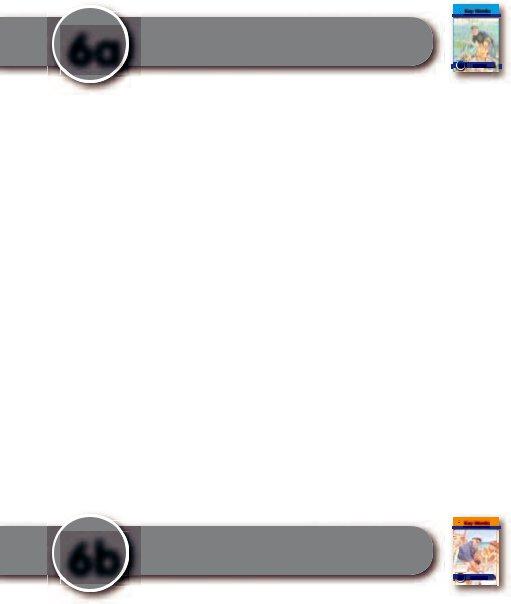
Help your children to write a very simple note of thanks from Peter and Jane to Sam and Bess’s parents. The note could be along the lines of:
Dear Mr and Mrs Collins (we do not know their name so we will call them Collins)
Thank you for a very good afternoon on your boat.
From Peter and Jane.
Key Words
WITH PETER AND JANE
6a |
Our friends |
|
6a |
Our friends |
This book offers you an exciting basis for a focus on friends.
Who can remember the names of Peter and Jane’s friends?
What do they do with their friends?
Ask you class who their friends are and ask them to tell you about their friends in this way:
My friend is… He/she lives next door to me and he sits next to me at school. I play ball with him after school.
Look at the pictures on pages 50 – 51. Ask your class to write a list of their friends and then to read them aloud.
Enjoy a class focus on horses. How do we use horses?
On Page 13, Peter asks, what is the time?
Choose an individual to ask this question and change the hour hand of your clock to various different hours and ask your class to tell you what the time is.
Peter and Jane visit their grandparents. Talk about visits. Who do members of your class visit and how do they travel there? Give them words they do not know.
Key Words
WITH PETER AND JANE
6b |
We like to help |
|
6b We like to help
Did your class enjoy reading about Tom’s boat? Would they like to live in a boat? Spend time talking about houses. Where would they most like to live – for example, in a tree house? in a block of lats? in a farm? by the sea? in a castle? in a cave?
Draw and label the house they would like best and then ask each child to talk to the rest of the class about it, what it is like and what is in it.
Ask each member of your class to write a short letter from Peter and Jane to Bob and Mary telling them about Tom’s boat, and the boy who was in danger.
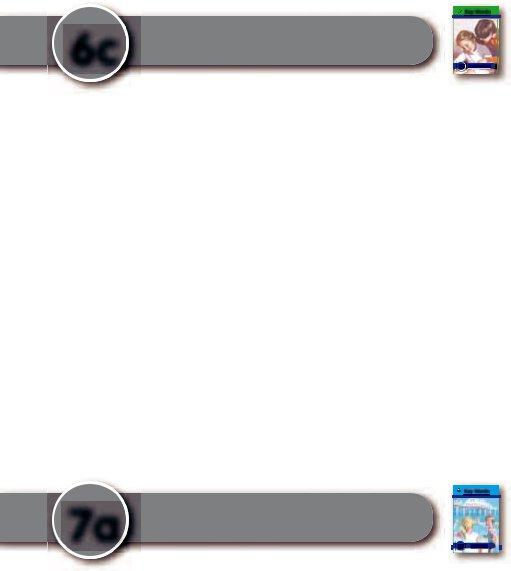
Key Words
WITH PETER AND JANE
6c |
Reading with sounds |
|
6c Reading with sounds
When your class has read pages 6 – 27 several times, cover the text and ask the children to look at the illustrations and to say the sounds and what the pictures show.
Enjoy a sound quiz. Ask a child to choose a letter/sound and write it on the blackboard.
Ask the other children how many words beginning with the same letter/sound they can write in ive minutes. The child with the most words chooses the next sound.
Look again at the letter on page 30 and spend time talking about letters.
Show your class how letters are set out, with the address and the date.
Explain how the address is written on the envelopes.
Have they received many letters? Do they have cards on their birthday?
This would be a good time to begin a class
Ask your class to tell you what happened in grandfather’s garden!
Key Words
WITH PETER AND JANE
7a |
Happy Holiday |
|
7a Happy holiday
When you have read this book, ask your class to tell you all they can remember about Peter and Jane’s holiday. Use this as a basis of a focus on holidays.
Ask your class where they have been on holiday and ask individuals to tell you about their holidays.
After this, talk about where your class would like to go on holiday and make a list of all the places they would like to visit, giving them any English words they do not know.
Ask your class to make up a holiday timetable with items like this
8.0o’clock: I will wake up and I will get up
9.0o’clock: I will eat my breakfast
10.0o’clock: We will go to the sea and play on the sand
11.0o’clock: I will ride on a donkey
Help your class to learn the rhyme:
Rain, rain, go away
Come again another day
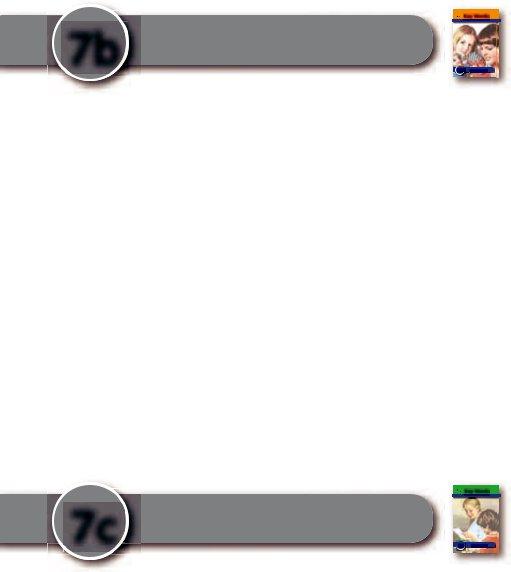
Do they know any other rhymes about the weather? Talk about types of weather and make a list of all the types of weather they know.
The weather is a great subject for mime. Ask individuals to mime being outside in different kinds of weather and the rest of the class can guess what kind of weather it is.
Key Words
WITH PETER AND JANE
7b |
Fun and games |
|
7b Fun and games
Ask individuals to tell you the story of Peter and Jane’s kite.
Have your class lown a kite? What was it like?
Talk about things that ly and list as many of these on the board as you can.
Which do individuals like best? Who would like to go up in a balloon? Who would like to go in a rocket to the moon?
Talk about woods. What do we ind in woods?
Ask your class to tell a simple story called Lost in the wood.
Each individual takes a turn to contribute one line to keep the story going.
The story can begin:
Once upon a time, there were two children who wanted to go into a wood.
Have you any puppets in your school? Would your class like to use these to turn Lost in the wood into a simple play?
Would your class like to make and label a big picture like Peter and Jane’s school did (see pages
42 – 49).
Key Words
WITH PETER AND JANE
7c |
Easy to sound |
|
7c Easy to sound
Look at pages 6 and 7 and talk about cooking.
What can the members of your class cook? What are their favourite foods?
Explain the word recipe to them and ask them to write down a simple recipe for something they can cook. Give them any English words they do not know.
Read again pages 32 – 42 and remind your class about the way letters are written with the address and the date. Remind them about the correct way to write the address on the envelope. Ask your class to write a letter to a friend telling them about a holiday. They can draw a picture to go inside the letter, too. Talk about the ways in which emails and text are different from letters.
Would your class like to work as a isherman? What would they like to do when they are
older? Ask them to write a few sentences beginning:
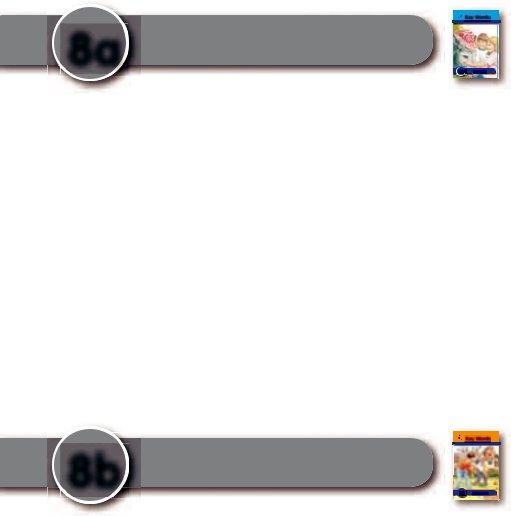
When I am older, I would like to be a …..
Ask each member of the class to read their sentences aloud.
Key Words
WITH PETER AND JANE
8a |
Sunny days |
|
8a |
Sunny days |
Ask your class to tell you the story of the donkey. Where did Pam ind him? What do you think
his life was like on the beach?
Peter and Jane play hide and seek.
Explain ‘rules’ to your class. What are the rules for hide and seek? What other games do your class know? Can they tell you the rules for them? Give them any new words they need.
Ask your class to tell you the story of the lost puppy.
Ask them if they have ever been lost or lost something important? Can they tell the story?
Peter, Jane and Pam play schools in the barn. Ask your class who would like to take a turn as teacher! Ask them to see if your class know their colours in English, using objects around the room. Another child can see if the class know their numbers. Choose other simple topics, too.
A class
Practise by looking at pages 39 and 41 and describing what Peter and Jane are wearing.
Key Words
WITH PETER AND JANE
8b |
The big house |
|
8b The big house
Continue to focus on letters, emails and texts.
Why do we write letters? What kind of letters do your class receive – and the members of their family? Where do we post letters? Who collects and delivers the letters? Who knows what happens to them in between collection and delivery?
Talk about emails and texts
Who do we email and text? How are these different from letters and postcards?
Talk about hats.
Who wears hats? How many types of hat can they think of? Do they wear hats? Does anyone in his or her family wear a hat?
Ask your class to draw a funny hat each and colour it. Then ask them to display it to the class and choose individuals to describe what they see.
Compose exercises to help your class understand the difference between too and two.
Exercises such as these are ideal:
I am … busy.
I have … cakes.
We were … late.
They are … tall.
We need … coats.

Ask your class to make up their own sentences containing either too or two.
Talk about gardens.
Who can remember what was in Mr White’s garden? What did Peter and Jane do in it? Who can tell you some of the rules of cricket?
Key Words
WITH PETER AND JANE
8c |
Fun with sounds |
|
8c Fun with sounds
Bring some postcards to show to the class.
Then ask them to write a few words about a holiday and to write an address.
Who would they like to send their postcard to?
Talk about stamps.
What do they know about stamps? Do any members of the class collect stamps?
Would they like to bring in some (used) stamps so that you can start a class stamp collection.
Talk about collections.
What do people collect? Do they collect anything?
Enjoy a sound quiz.
How many words can your class think of with st in them? With ll ?
Enjoy doing this with as many sounds as you can. It’s fun to write the sounds on small pieces of card, put them into a container and put your hand in to choose one – or ask each child in turn to put their hand in the sound lucky dip!
Look at all the individual pictures on pages 17, 19,21, 23, 25, 27, 29, and 31. Ask each member of your class to choose one of these pictures and to write a few sentences about it, making up a story. Enjoy a long session hearing all these stories.
Two boys enjoy a sack race (p 44). Have your class ever had a sack race? What other games do they know? Can they write down some simple rules for them. Give them all the help they need.
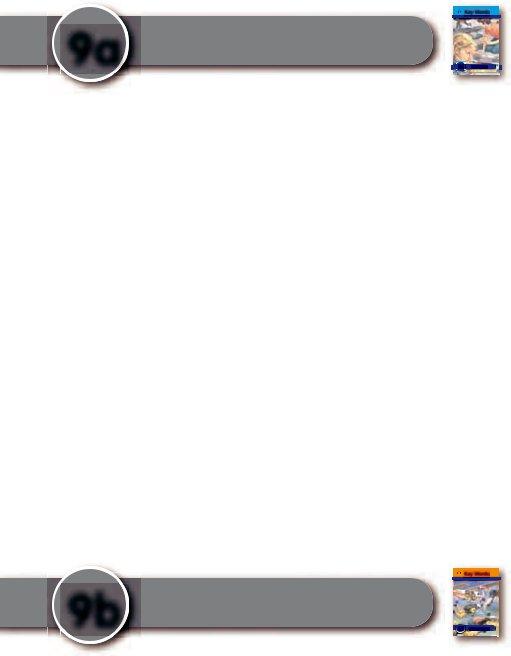
Key Words
WITH PETER AND JANE
9a |
Games we like |
|
9a Games we like
The toyshop on page 5 will make an ideal what can you remember quiz.
Ask your class to look at the picture for two minutes. Then shut the book and ask them to write down as many items as they can remember!
Talk about games.
What games do Peter and Jane play with their friends? What games do your class like to play with their friends? How do they play these games?
The children’s game of doctors and nurses (14/15) is a good base for a discussion about doctors and hospitals. Talk about visits to the doctor and give them any new words they need.
Why do we go to the doctor? How does she help us? Have they ever been to hospital? What happened?
What do the children do in the woods? Talk about the old, empty house. Ask them to each make up a story about this house. They could begin, When I went into the house…
They could either tell their story aloud, or write it down in simple sentences beforehand and read it out.
Can you organise a game of Treasure Hunt for your class?
How many cooking words can your class remember? Who has made cakes? Who has tasted a toffee apple? What is each member’s favourite meal? Make a list of favourite meals.
Key Words
WITH PETER AND JANE
9b |
Jump from the sky |
|
9b Jump from the sky
Talk about what happens at the air display and give your class any new words.
Have any of your class been in a plane? Did they enjoy it? Where did they go? Would they like to jump from a plane?
Revise the vocabulary of things that ly. How many lying things can your class spot on pages 5
–13? Now close the book.
Ask your class to write a list of these things. Who can write the longest list in ive minutes? Ask each child to read his or her list aloud.
Are there any missing?
Ask your class to tell you who received a message tied to a balloon.
Would your class like to do this? Attach the school address to balloons and set the balloons free. Ask them to write the story: The story of my balloon imagining where their balloon went and who found it.
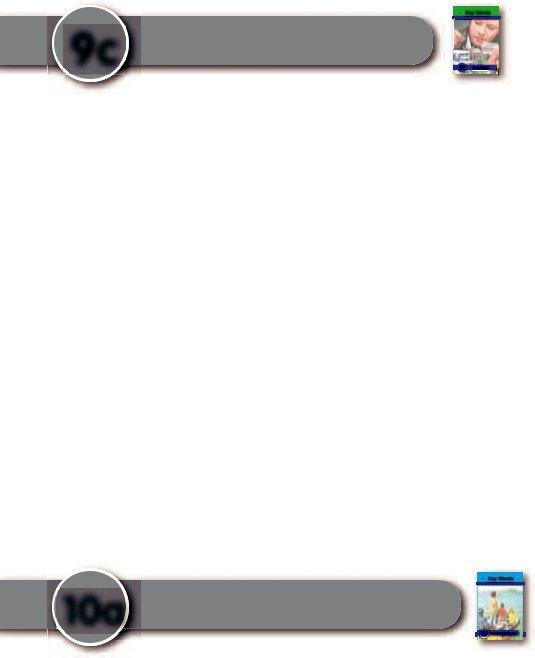
Have your class blown bubbles? You can see the colours of the rainbow in them.
Who can tell you what these seven colours are? Can your class draw rainbows and label them with the seven colours.
The children in the book enjoy watching the cowboy and Indian ilm. Which ilms have your class seen? Can they tell you what happened in these ilms?
Revise hospital vocabulary. Who can tell the story of the boy in the empty house?
Key Words
WITH PETER AND JANE
9c |
Enjoying reading |
|
9c Enjoy reading
Turn the story of the boy who fell through the ice into a simple play.
Help your class to write dialogue for the boy, the park keeper, the three friends and two grownups. Talk about the things they might say and do. Then act the play, using the dialogue.
Choose ten words that your class has learned in this book (such as birthday, branch, and puddle). Give your class these words one at a time and ask them to write each in a short sentence such as I fell in the puddle. Allow your class plenty of time to think of these sentences and then to write them. When all ten sentences have been written, ask each member of the class to read his or her list and enjoy hearing how different the sentences are.
In a later session, do this using ten different ten words – or ask the children to choose ten words to dictate to the others.
Continue the story focus begun with Book 8c. Ask the children to choose one of the many small pictures and write a story about their choice.
1.
2.
3…etc.
Give them any new words they need.
Key Words
WITH PETER AND JANE
10a |
Adventure on the island |
|
10a Adventure on the island
Can your class remember what Peter, Jane and their cousins did on their island? What happened after the storm?
Would your class like to own an island? Ask them to each draw a plan of their island. What will be on it? Ask them to label trees, lakes, big rocks, houses, hills, woods, waterfalls and paths.
What will they call their own island?
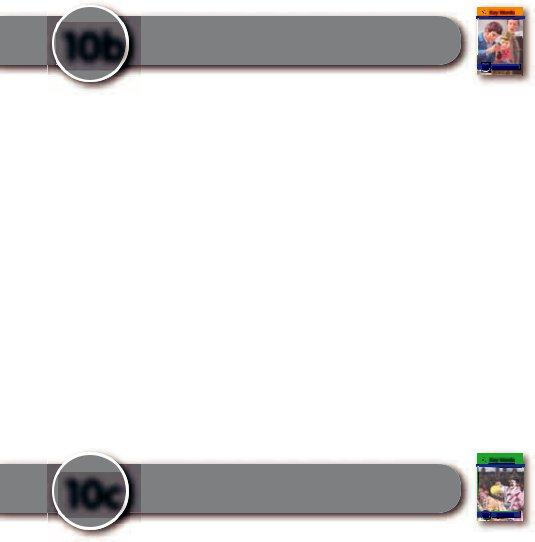
Have your class experienced a storm? What was it like? Revise weather vocabulary.
Tell your class that they are going to write their own stories about being trapped and rescued, and make sure they understand these words.
Talk about where they could be trapped and give any new words they need. Your class could be trapped on the island, up a tree, in a cave, in the forest, in the desert, underground – or anywhere else they can think of! Ask them to write these stories in their exercise books and give them lots of time. Enjoy hearing these stories in class.
Key Words
WITH PETER AND JANE
10b |
Adventure at the castle |
10b Adventure at the castle
Ask your class to tell you the story of John and Simon and the castle. Individuals could each tell episodes until the whole story is complete.
Focus on castles. What do they know about castles? What castles have they seen?
Just as they imagined owning an island (Book 10a), so now they can imagine having their
own castle. What is it like? Does it have a moat around it? Does it have secret rooms and passages? Is there treasure hidden somewhere in the castle? Do they ind a secret
message?
Now ask each member of the class to write a story about their own castle. Again, allow lots of time and enjoy hearing these stories read aloud.
Simon and John go camping. Have any of your class been camping? Can they tell you how to put up a tent?
The story of John and Simon and the castle would make an exciting play. Let the children act it using their own words.
Events in this story give you the opportunity to revise and extend hospital and weather vocabulary.
Key Words
WITH PETER AND JANE
10c |
Learning is fun |
|
10c Learning is fun
Choose ten words that your class has learned in this book (such as blanket, pebbles, ribbon) Give your class these words one at a time and ask them to write each in a short sentence such as My sister put on a red ribbon. Allow your class plenty of time to think of these sentences and then to write them. When all ten sentences have been written, ask each member of the class to read his or her list and enjoy hearing how different the sentences are.
In a later session, do this using ten different ten words – or ask the children to choose ten words to dictate to the others.
Have any of your class had an accident? What happened and who helped? Ask them to each write four sentences about an accident and it can be real or imaginary.
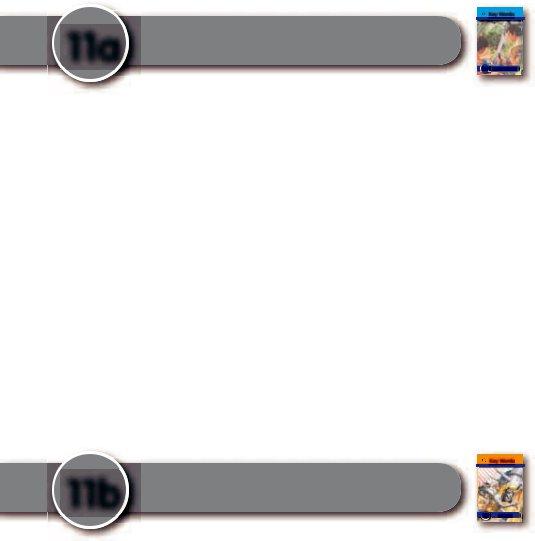
dialogue for three people. What would the man at sea say? What would the two men in the
helicopter say? Ask your class to write this dialogue.
In a later session,
Key Words
WITH PETER AND JANE
11a |
Mystery on the island |
|
11a Mystery on the island
Ask your class to tell the story of the mystery on the island. Each class member can tell one episode and then pass the story over to another, until the whole story is inished.
Talk about mysteries and clues.
What were the clues that Ron Dare was on the island?
Where did they search for Ron Dare?
Do your class like mystery stories and television programmes about mysteries?
How many of these can you list on the board?
Tell your class you are going to ask them to write a story about a runaway, and that you will be talking about it irst. Give them any new words they need. Talk about who could run away. It could
be a child, a dog, cat, sister, brother …. How could they be found? Will there be clues?
Talk about happy endings and unhappy endings. Will their story have a happy ending?
Now give them time to write their story, and enjoy hearing these read out loud.
Key Words
WITH PETER AND JANE
11b |
The carnival |
|
11b |
The carnival |
Can your class remember what the boys used to make their rocket on the lorry? Ask them
to reply: The boys used wire. The boys used wood. etc
Ask your class to form into groups of 3 – 4. Each group is to imagine they had a lorry to decorate. The group must choose how it is to be decorated and then make list of all the things they will need.
Our lorry is going to be decorated as a ……
We will need these things:

Tell the group that they can draw their design if this helps them to decide what will be needed.
Give the groups lots of time, and when they are inished, ask one member of each group to tell the class what was decided, and what will be needed.
Look again at pages 16 – 17.
What fancy dress costumes can you see there? Ask each member of the class to choose a fancy dress – either from this page or from their imagination. Ask them to describe the fancy dress to the class.
Ask your class if they have ever been to a fair?
Did they do any of the things that Peter, Jane and their cousins did?
Use the episode of the pet show (p 36 – 39) to revise and extend animal vocabulary.
Who can write the longest list of animals?
Key Words
WITH PETER AND JANE
11c |
Books are exciting |
11c Books are exciting
This offers an exciting focus on books.
Can your class remember the books the children read? Which books do your class like best? Ask each class member to write ive sentences about his or her favourite book, and to explain why they like this book.
Remind them to include the title of the book!
Talk about libraries. Do you have a school or a class library? This focus on books offers your class an opportunity to enjoy
Look at pages 14 - 15 and see if your class can tell you the names for the parts of the body.
This book offers you the chance to practise reading for information.
Choose one of the information pages and ask your class to
Talk about games like pin the tail on the donkey. Explain pass the parcel, musical chairs, hide and seek. Do your class know how to play these? What party games do they play?
What are the rules?
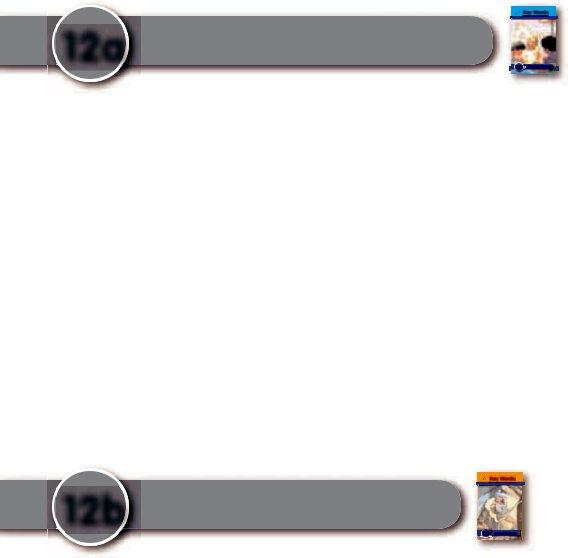
Key Words
WITH PETER AND JANE
12a The Holiday Camp Mystery
12a The holiday camp mystery
Ask your class to retell the story. Each member can tell one episode in his or her own words. Continue this around the class until the story is complete.
Simon and John meet the foreman of the building site. Talk again with your class about occupations. What kind of jobs are there on a holiday camp? What kind of jobs are there in the countryside? What kind of jobs are there in a Bank? What kind of jobs are there in a school? What kind of jobs are there in an airport? What kind of jobs are there in a hospital? What kind of jobs are there in a shop?
Tell your class that they are going to write about inding a secret tunnel, and that you are going to talk about this irst. Where could they ind a secret tunnel? How would they ind it? Would they go along it on their own? What would they ind?
Ask them to write a short story about this. Give them lots of time, and enjoy a class read out of these stories.
Bring in newspapers and talk about articles and headlines. Tell the class they are going to write a newspaper report about the smuggler in the story. What will the headline be? Talk about the content of the report. Ask each member to write this report and enjoy hearing these.
Key Words
WITH PETER AND JANE
12b Mountain adventure
12b Mountain adventure
This story follows on from Book 10b Adventure at the castle.
Can your class remember what happened in that story?
Have any of your class belonged to a club? Ask your class to get into groups of 3 or 4. Each group will talk about starting a club. Talk about what kind of club this will be and what the members of the club will do. What kind of building would they like and what kind of equipment will they need? What will they call their club? Will there be a membership fee? Who will be in charge?
Ask the group to write about their club and to prepare a list of rules for their club.
Allow plenty of time for this. Later on, ask one member of the group to tell the rest of the class what has been decided.
Have any of your class been up a mountain? Do they know where mountains are found?
Talk about being high up.
Where else can we be high up?

Key Words
WITH PETER AND JANE
12c |
The open door to reading |
|
12c The open door to reading
The short extracts offer your class the opportunity to try classic stories. They also offer an exciting basis for writing.
The little bookroom : ask your class to talk about fortunetellers and to write about seeing a fortuneteller and what happened. Did the fortune come true?
Black beauty : ask your class to imagine they are a baby lion, a baby elephant or a baby penguin. Can they write about their life?
Treasure Island: ask your class to write about a dangerous journey by sea.
Nicholas Nye: ask your class to write about an animal they have observed or know well.
Thumbelina : can your class imagine being very tiny? What would the classroom be like?
The Pied Piper of Hamelin: ask your class to write about seeing a lot of rats in the classroom!
How the whale got his throat: can your class imagine being swallowed by a whale?
From a railway carriage: ask your class to write a short account of what they see from the window of a railway carriage.
Swallows and amazons: talk about snakes and ask your class to imagine inding a snake when they are out camping. Can they write the story of what happened next?
Nordy Bank: ask your class to imagine what happens to the runaway dog – and to write the next episode.
The boy’s song: where do your class like to play with their friends? Can they write a very short song about it?